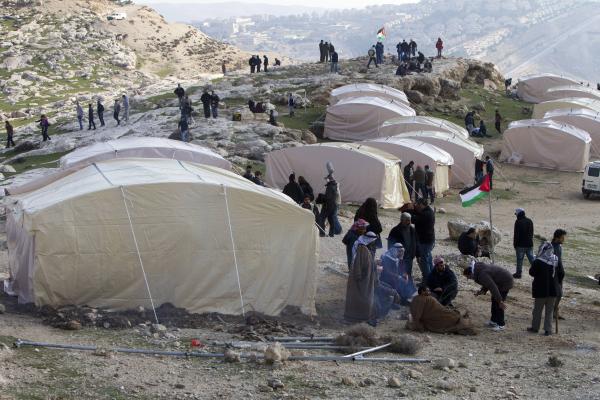Last week, while most of Israel was focused on increasingly extreme rhetoric surrounding the upcoming elections and most Americans were listening to angry debates about guns and fiscal responsibility, a remarkable thing happened. A few dozen Palestinians captured the world’s attention quietly and peacefully.
Their methods were simple and witty. Following the example of Israeli settlers, they established “facts on the ground.” The group of Palestinians quietly hiked up a barren hillside in cold, wet weather and pitched tents, declaring themselves part of the new village of Bab al-Shams, or Gate of the Sun, a name taken from the novel by Lebanese writer Elias Khoury.
Their village was established on private, Palestinian land and the landowner (who publicly displayed his Ottoman era deed) gave them permission to camp there. But that particular piece of land is also known on an Israeli development plan map as “E-1” and came to the attention of the world recently when Prime Minister Netanyahu announced plans to annex the land for Israeli settlements. Many believe that move, which would essentially bifurcate the West Bank, would be the deathblow to the “Two State Solution.”
Some of the Palestinians came alone; others came in small groups. They passed through checkpoints where they showed their identity cards and allowed their bags to be searched by Israeli military. They were reportedly polite and cooperative. None carried weapons and most had trained in the methods of peaceful resistance. They were not looking for a fight.
By Friday they had established Facebook and Twitter accounts, and that’s when the little village became an international phenomenon. Their Facebook following increased by hundreds and then thousands. Their Tweets were seen by activists and then major news organizations. By Saturday, articles about their village showed up in the New York Times, The Guardian, Al-Jazeera, and on international broadcasts.
By midday Saturday, Palestinians from all over the West Bank began hiking toward the camp, trying to join it. But by then the Israeli military had surrounded the group and no one else was allowed in. Reporters protested and the military declared it a “military zone.” But the Israeli courts ruled that the activity of the Palestinians was legal and the tents could not be removed.
The Prime Minister urged the courts to rethink their ruling and by Saturday night, 600 Israeli police moved in to take away the 200 Palestinians, placing them on buses and depositing them near the West Bank city of Ramallah. The entire eviction was captured and posted on YouTube. They were not arrested or detained, and by all accounts the Israeli police mostly acted with restraint, although six Palestinians were taken to hospitals due to injuries. The tents remain, since the court ruling allowed for the removal of the people but not the structures.
On Sunday, Israeli Prime Minister Netanyahu was claiming victory, but messages on the village’s Facebook page from all over the world told a different story. A small group of Palestinian peace activists had transformed an abstract political concept from “E-1” to the village of Bab al-Shams. They had attracted the world’s attention by being peaceful and clever and inviting the world in to share their village. Those who underestimate the value of the methods or the medium only have to ask a few dozen Palestinians, who, in three short days, captured the attention of thousands around the world.
Follow Bab al-Shams at www.facebook.com/Babalshams2013 and on Twitter @Bab_AlShams.
Dale Hanson Bourke’s next book is The Israeli-Palestinian Conflict (IVPress) part of her “Skeptic’s Guide” series. www.facebook.com/skepticsguides or @DaleHBourke
Got something to say about what you're reading? We value your feedback!
